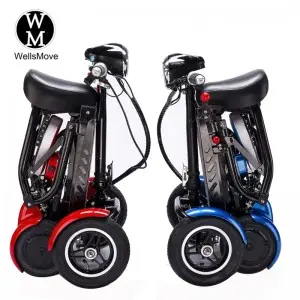Vehicle performance test of mobility scooters for the elderly: the key to ensuring safety and quality
In today’s society, with the intensification of the trend of population aging, mobility scooters for the elderly have become one of the important tools for the elderly to travel daily. For international wholesale buyers, it is crucial to ensure that the mobility scooters purchased have excellent performance, which is not only related to the market competitiveness of the products, but also to the travel safety and use experience of the elderly. Therefore, it is of great significance for buyers to have a deep understanding of the specific items of vehicle performance testing of mobility scooters for the elderly.
Power performance test
Maximum speed test: On a flat road, use professional speed measuring equipment to measure the acceleration of mobility scooters for the elderly to the maximum speed when fully loaded and unloaded. Generally, the maximum speed is required not to exceed 25km/h to ensure the safety of the elderly during use.
Acceleration performance test: Test the time required for the vehicle to accelerate from a stationary state to a certain speed, such as the acceleration time of 0-15km/h and 0-20km/h. This can reflect the power response speed of the vehicle when starting and driving at medium and low speeds, which is of practical significance for driving scenarios such as starting and overtaking at intersections for the elderly.
Climbing ability test: Select slope sections with different slopes, usually including 5%, 10%, 15% and other slopes, and let the elderly scooter fully loaded and unloaded to perform climbing tests respectively, and record whether the vehicle can successfully climb to the top of the slope and the power performance during the climbing process. Good climbing ability can ensure that the vehicle can be used normally under different road conditions, such as dealing with slopes in communities, parks, etc.
Braking performance test
Braking distance test: On a dry and flat road, let the elderly scooter drive at different speeds, such as 15km/h, 20km/h, 25km/h, etc., and then brake urgently, and measure the distance from stepping on the brake pedal to the vehicle completely stopping. Generally speaking, when the speed is 20km/h, the braking distance should not exceed 4 meters to ensure that the vehicle can stop in time in an emergency and avoid accidents.
Braking stability test: Observe whether the vehicle maintains a straight line during braking, and whether there is deviation, side slip, etc. This can be judged by checking the vehicle’s driving trajectory and the contact between the tires and the ground during braking, ensuring that the vehicle has good stability and controllability during braking.
Braking strength test: Evaluate the strength and reliability of the braking system by measuring the braking force of the braking system within a certain period of time. The braking force should be large enough and evenly distributed to ensure the braking effect of the vehicle under various working conditions.
Steering performance test
Minimum turning diameter test: In an open field, let the elderly scooter drive at a low speed, turn the steering wheel to make the vehicle move in a circle, and measure the diameter of the circle formed when the vehicle turns. A smaller minimum turning diameter means that the vehicle is more flexible on narrow roads or when parking, which is convenient for the elderly to operate and turn.
Steering lightness test: Under different road conditions, such as flat roads, bumpy roads, etc., feel the turning force of the steering wheel to determine whether the steering system is light and flexible. For the elderly, excessive steering wheel operation may cause driving fatigue and inconvenience in operation, so steering lightness is one of the important test items.
Steering accuracy test: By setting some specific turning paths and obstacles, observe whether the steering response of the vehicle during driving is accurate, and whether the steering action can be completed accurately according to the driver’s intention to ensure the driving safety and stability of the vehicle.
Safety performance test
Collision safety test: Simulate the accident scenes such as frontal collision and side collision that may occur during the driving of the vehicle, use professional collision test equipment to conduct collision tests on the elderly scooters, and detect the vehicle’s body structure strength, passenger compartment protection performance, and the effectiveness of safety devices such as seat belts and airbags. Although the speed of the elderly scooters is relatively low, it may still cause harm to the occupants in a collision accident, so collision safety testing is essential.
Stability test: Including static stability and dynamic stability tests. The static stability test mainly measures the roll angle, longitudinal stability and other parameters of the vehicle in a stationary state; the dynamic stability test is to observe the stability performance of the vehicle during the driving process through rapid acceleration, sudden braking, rapid steering and other operations, such as whether there is a phenomenon of roll, loss of control, etc., to evaluate the stability of the vehicle under various driving conditions and prevent the vehicle from overturning and other dangerous situations during driving.
Electrical safety test: Check the electrical system of the vehicle, such as the insulation, conductivity, and waterproof performance of components such as batteries, motors, controllers, and lamps. Ensure that the electrical system will not have leakage, short circuit, and other faults under normal working conditions to ensure the safety of the elderly. At the same time, the vehicle’s charging system also needs to be tested, including the safety of the charging interface and temperature control during charging.
Endurance performance test
Endurance mileage test: Under different road conditions and load conditions, such as flat roads, bumpy roads, uphill sections, etc., as well as full load and no load conditions, the endurance mileage of the elderly scooter is tested. Record the maximum mileage that the vehicle can travel when the battery is fully charged to evaluate the vehicle’s endurance. Generally speaking, the endurance mileage under urban conditions should be no less than 20 kilometers to meet the daily travel needs of the elderly.
Battery life test: By performing multiple charge and discharge cycle tests on the battery, the capacity changes of the battery under different cycle times are recorded to evaluate the battery life. The battery life should be no less than 200 cycles, and the capacity retention rate should be no less than 80% to ensure the normal use of the vehicle for a long time.
Comfort test
Seat comfort test: Evaluate whether the material, hardness, support, etc. of the seat conform to the principles of ergonomics and whether it can provide good riding comfort for the elderly. The seat should be soft and elastic enough to relieve fatigue from long-term riding; at the same time, the height and angle of the seat should be adjustable to meet the needs of different elderly people.
Shock absorption performance test: Place the vehicle on a road with different degrees of bumps, such as a cement road, a gravel road, etc., and let the elderly drive the vehicle to feel the shock absorption effect of the vehicle. The shock absorption performance can be quantified by measuring the vibration acceleration, frequency and other parameters of the vehicle during driving to ensure that the vehicle can effectively filter road bumps during driving and provide a comfortable riding experience for the elderly.
Noise test: During the driving of the vehicle, use a noise detector to measure the noise level in the car, including motor noise, tire noise, wind noise, etc. The noise should be controlled within a reasonable range, generally not exceeding 70 decibels, to create a quiet and comfortable driving environment.
Vehicle handling performance test
Handling ease test: In addition to steering ease, it also includes ease tests for transmission, clutch and other operations. Check whether the gear shift is smooth and whether the clutch pedal is moderate, to ensure that the elderly do not feel too strenuous when operating the vehicle and can easily perform operations such as shifting and starting the vehicle.
Driving stability test: Observe the driving stability of the vehicle at different speeds and road conditions, such as whether there is shaking, swinging and other phenomena. The vehicle should remain stable during driving, and there will be no obvious bumps or shaking due to changes in speed or uneven road surface, so as to improve the driving safety and comfort of the elderly.
Passability test: Measure the vehicle’s minimum ground clearance, approach angle and departure angle and other parameters to evaluate the vehicle’s ability to pass through obstacles, ditches and other complex road conditions. Good passability can enable the elderly scooter to adapt to more usage environments, such as road conditions in rural and mountainous areas, and increase the scope of application of the vehicle.
Vehicle reliability test
Durability test: Place the mobility scooter on a special durability test bench to simulate various working conditions of the vehicle during long-term use, such as continuous driving, frequent start-stop, turning, etc., and conduct long-term durability tests on the vehicle’s entire vehicle structure, parts, etc. Observe the wear and aging of the vehicle’s parts after a certain mileage or time to ensure the service life and reliability of the vehicle.
Environmental adaptability test: Including tests under high temperature, low temperature, high humidity and other environmental conditions. Place the vehicle in different environmental test chambers to simulate extreme weather conditions, such as high temperature exposure, low temperature freezing, high humidity, etc., to detect whether the vehicle’s starting, driving, charging and other performances in these environments are normal, and whether the parts will fail or be damaged, in order to verify the environmental adaptability of the vehicle.
Key component reliability test: Conduct separate reliability tests on key components of the vehicle, such as motors, controllers, battery management systems, etc. Through long-term power-on, operation and other tests, check the stability and reliability of key components to ensure that they can work normally during the use of the vehicle, and no sudden failures will occur, affecting the normal driving of the vehicle and the safety of the elderly.
Summary
The performance test of mobility scooters for seniors covers specific items in power, braking, steering, safety, endurance, comfort, handling, reliability, etc. These test items are interrelated and mutually influential, and together determine the overall performance and quality of the vehicle. For international wholesale buyers, when purchasing mobility scooters for seniors, they must strictly require suppliers to conduct comprehensive performance tests on the vehicles and provide detailed and accurate test reports and certification certificates, such as FDA 510K certification, CE certification, etc., to ensure that the purchased products meet international market standards and safety requirements, and have good market competitiveness and user reputation.
Post time: May-16-2025



